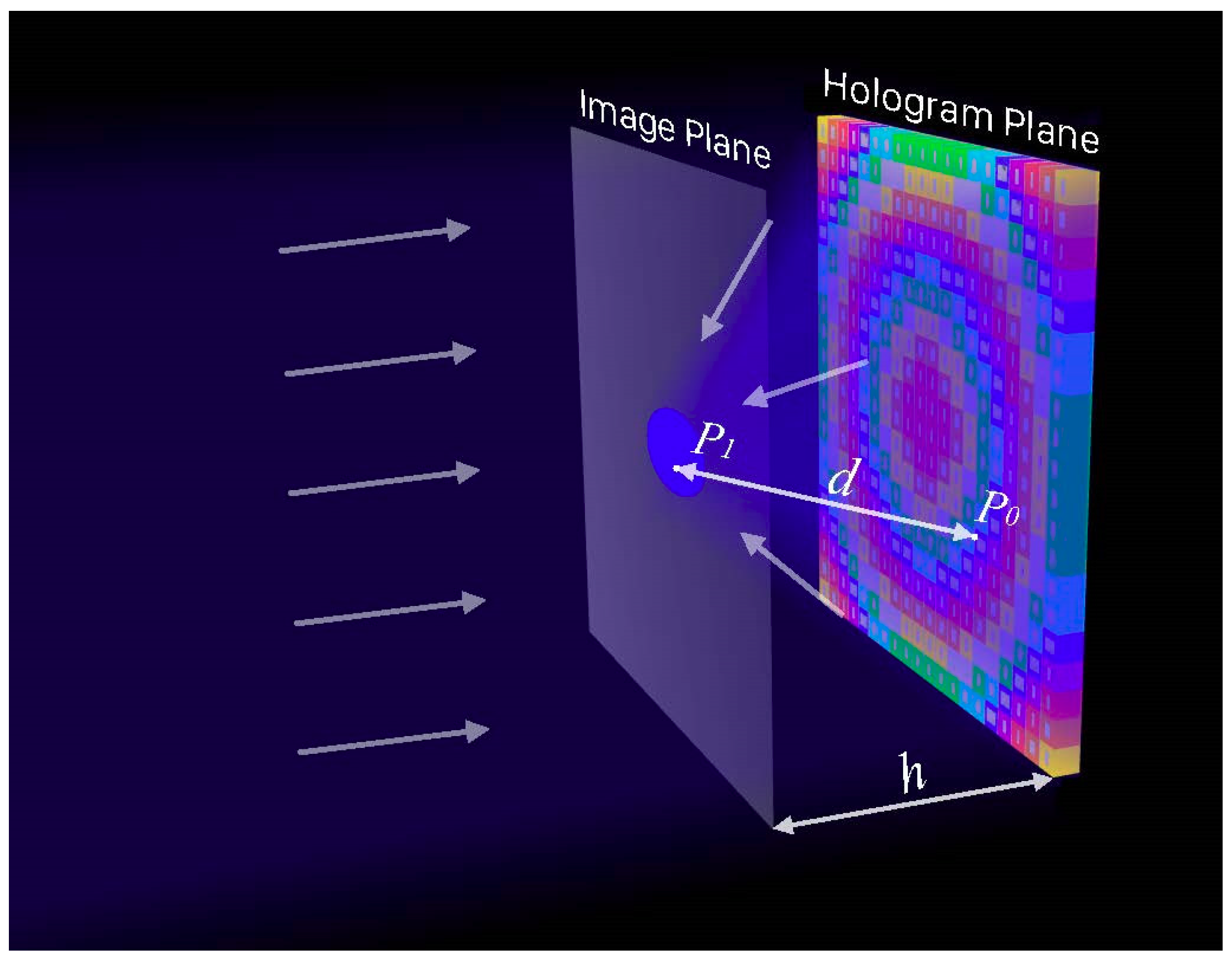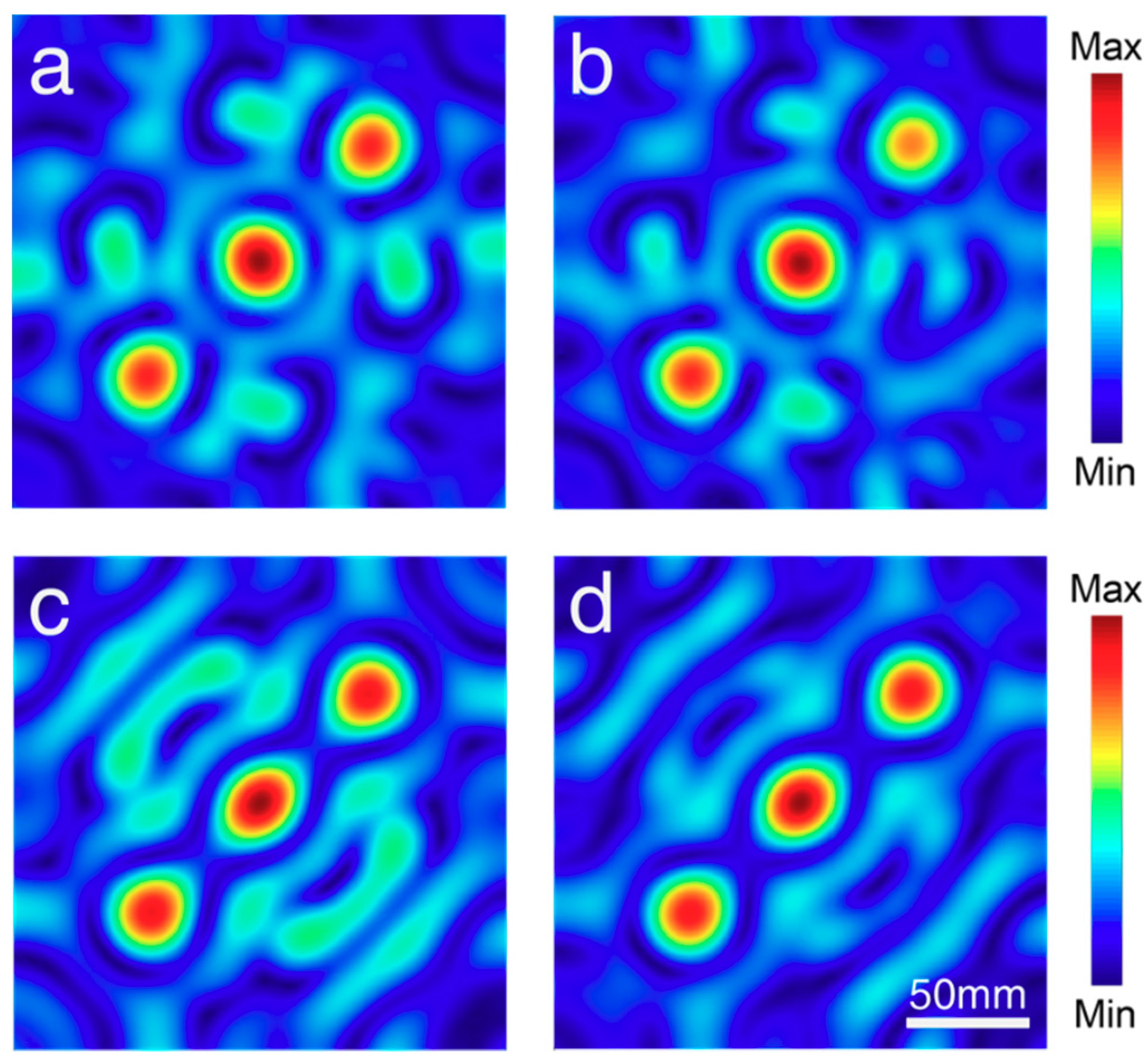Ultrathin Acoustic Metasurface Holograms with Arbitrary Phase Control
Abstract
:Featured Application
Abstract
1. Introduction
2. Results and Discussion
3. Conclusions
Author Contributions
Funding
Conflicts of Interest
References
- Kompisk, M.; Pasterkamp, H.; Wodicka, G.R. Acoustic imaging of the human chest. Chest 2012, 120, 1309–1321. [Google Scholar] [CrossRef] [PubMed]
- Von Deimling, J.S.; Greinert, J.; Chapman, N.R.; Rabbel, W.; Linke, P. Acoustic imaging of natural gas seepage in the North Sea: Sensing bubbles controlled by variable currents. Limnol. Oceanogr. Methods 2010, 8, 155–171. [Google Scholar] [CrossRef]
- Rietbrock, A.; Scherbaum, F. Acoustic imaging of earthquake sources from the Chalfant Valley, 1986, aftershock series. Geophys. J. Int. 1994, 119, 260–268. [Google Scholar] [CrossRef] [Green Version]
- Piyasena, M.E.; Suthanthiraraj, P.P.A.; Applegate, R.W., Jr.; Goumas, A.M.; Woods, T.A.; López, G.P.; Graves, S.W. Multinode acoustic focusing for parallel flow cytometry. Anal. Chem. 2012, 84, 1831–1839. [Google Scholar] [CrossRef] [PubMed]
- Gabor, D. A new microscopic principle. Nature 1948, 161, 777–778. [Google Scholar] [CrossRef] [PubMed]
- Leith, E.N.; Upatnieks, J. Reconstructed wavefronts and communication theory. J. Opt. Soc. Am. 1962, 52, 1123–1130. [Google Scholar] [CrossRef]
- Scheuer, J.; Yifat, Y. Metasurfaces make it practical. Nat. Nanotechnol. 2015, 10, 296–298. [Google Scholar] [CrossRef]
- Schnars, U.; Falldorf, J.W.C.; Jüptner, W. Digital Holography and Wavefront Sensing: Principles, Techniques and Applications; Springer: Berlin/Heidelberg, Germany, 2015; pp. 39–68. [Google Scholar]
- Wyrowski, F.; Hauck, R.; Bryngdahl, O. Computer-generated holography: Hologram repetition and phase manipulations. J. Opt. Soc. Am. A 1987, 4, 694–698. [Google Scholar] [CrossRef]
- Kelly, D.P.; Monaghan, D.S.; Pandey, N.; Kozacki, T.; Michalkiewicz, A.; Finke, G.; Hennelly, B.M.; Kujawinska, M. Digital holographic capture and optoelectronic reconstruction for 3-D displays. Int. J. Digit. Multimed. Broadcast. 2010, 2010. [Google Scholar] [CrossRef]
- Slinger, C.; Cameron, C.; Stanley, M. Computer-generated holography as a generic display technology. Computer 2005, 38, 46–53. [Google Scholar] [CrossRef]
- Yu, N.; Genevet, P.; Kats, M.A.; Aieta, F.; Tetienne, J.P.; Capasso, F.; Gaburro, Z. Light propagation with phase discontinuities: Generalized laws of reflection and refraction. Science 2011, 334, 333–337. [Google Scholar] [CrossRef] [PubMed]
- Ni, X.; Emani, N.K.; Kildishev, A.V.; Boltasseva, A.; Shalaev, V.M. Broadband light bending with plasmonic nanoantennas. Science 2012, 335, 427. [Google Scholar] [CrossRef] [PubMed]
- Sun, S.; He, Q.; Xiao, S.; Xu, Q.; Li, X.; Zhou, L. Gradient-index meta-surfaces as a bridge linking propagating waves and surface waves. Nat. Mater. 2012, 11, 426–431. [Google Scholar] [CrossRef] [PubMed]
- Yin, X.; Ye, Z.; Rho, J.; Wang, Y.; Zhang, X. Photonic spin Hall effect at metasurfaces. Science 2013, 339, 1405–1407. [Google Scholar] [CrossRef] [PubMed]
- Yang, Y.; Jing, L.; Zheng, B.; Hao, R.; Yin, W.; Li, E.; Soukoulis, C.M.; Chen, H. Full-Polarization 3D Metasurface Cloak with Preserved Amplitude and Phase. Adv. Mater. 2016, 28, 6866–6871. [Google Scholar] [CrossRef] [PubMed]
- Wang, Z.; Jia, H.; Yao, K.; Cai, W.; Chen, H.; Liu, Y. Circular Dichroism Metamirrors with Near-Perfect Extinction. ACS Photonics 2016, 3, 2096–2101. [Google Scholar] [CrossRef]
- Yang, Y.; Jing, L.; Shen, L.; Wang, Z.; Zheng, B.; Wang, H.; Li, E.; Shen, N.-H.; Koschny, T.; Soukoulis, C.M.; et al. Hyperbolic spoof plasmonic metasurfaces. NPG Asia Mater. 2017, 9, e428. [Google Scholar] [CrossRef]
- Qian, C.; Lin, X.; Yang, Y.; Xiong, X.; Wang, H.; Li, E.; Kaminer, I.; Zhang, B.; Chen, H. Experimental observation of superscattering. Phys. Rev. Lett. 2019, 122, 063901. [Google Scholar] [CrossRef]
- Aieta, F.; Genevet, P.; Kats, M.A.; Yu, N.; Blanchard, R.; Gaburro, Z.; Capasso, F. Aberration-free ultrathin flat lenses and axicons at telecom wavelengths based on plasmonic metasurfaces. Nano Lett. 2012, 12, 4932–4936. [Google Scholar] [CrossRef]
- Chen, X.; Huang, L.; Mühlenbernd, H.; Li, G.; Bai, B.; Tan, Q.; Jin, G.; Qiu, C.-W.; Zhang, S.; Zentgraf, T. Dual-polarity plasmonic metalens for visible light. Nat. Commun. 2012, 3, 1198. [Google Scholar] [CrossRef]
- Ni, X.; Ishii, S.; Kildishev, A.V.; Shalaev, V.M. Ultra-thin, planar, Babinet-inverted plasmonic metalenses. Light Sci. Appl. 2013, 2, e72. [Google Scholar] [CrossRef]
- Zheng, B.; Zhu, R.; Jing, L.; Yang, Y.; Shen, L.; Wang, H.; Wang, Z.; Zhang, X.; Liu, X.; Li, E.; et al. 3D Visible-Light Invisibility Cloak. Adv. Sci. 2018, 5. [Google Scholar] [CrossRef] [PubMed]
- Wang, C.; Yang, Y.; Liu, Q.; Liang, D.; Zheng, B.; Chen, H.; Xu, Z.; Wang, H. Multi-frequency metasurface carpet cloaks. Opt. Express 2018, 26, 14123–14131. [Google Scholar] [CrossRef] [PubMed]
- Yang, Y.; Wang, H.; Yu, F.; Xu, Z.; Chen, H. A metasurface carpet cloak for electromagnetic, acoustic and water waves. Sci. Rep. 2016, 6, 20219. [Google Scholar] [CrossRef] [PubMed] [Green Version]
- Hao, J.; Yuan, Y.; Ran, L.; Jiang, T.; Kong, J.A.; Chan, C.T.; Zhou, L. Manipulating electromagnetic wave polarizations by anisotropic metamaterials. Phys. Rev. Lett. 2007, 99, 063908. [Google Scholar] [CrossRef] [PubMed]
- Ni, X.; Kildishev, A.V.; Shalaev, V.M. Metasurface holograms for visible light. Nat. Commun. 2013, 4, 2807. [Google Scholar] [CrossRef]
- Zheng, G.; Mühlenbernd, H.; Kenney, M.; Li, G.; Zentgraf, T.; Zhang, S. Metasurface holograms reaching 80% efficiency. Nat. Nanotechnol. 2015, 10, 308–312. [Google Scholar] [CrossRef]
- Wang, Q.; Zhang, X.; Xu, Y.; Gu, J.; Li, Y.; Tian, Z.; Singh, R.; Zhang, S.; Han, J.; Zhang, W. Broadband metasurface holograms: Toward complete phase and amplitude engineering. Sci. Rep. 2016, 6, 32867. [Google Scholar] [CrossRef]
- Melde, K.; Mark, A.G.; Qiu, T.; Fischer, P. Holograms for acoustics. Nature 2016, 537, 518–522. [Google Scholar] [CrossRef]
- Marzo, A.; Seah, S.A.; Drinkwater, B.W.; Sahoo, D.R.; Long, B.; Subramanian, S. Holographic acoustic elements for manipulation of levitated objects. Nat. Commun. 2015, 6, 8661. [Google Scholar] [CrossRef] [Green Version]
- Zhu, R.; Zheng, B.; Ma, C.; Xu, J.; Fang, N.; Chen, H. A broadband polygonal cloak for acoustic wave designed with linear coordinate transformation. J. Acoust. Soc. Am. 2016, 140, 95–101. [Google Scholar] [CrossRef] [PubMed]
- Li, Y.; Jiang, X.; Liang, B.; Cheng, J.-C.; Zhang, L. Metascreen-based acoustic passive phased array. Phys. Rev. Appl. 2015, 4, 024003. [Google Scholar] [CrossRef]
- Ma, G.; Yang, M.; Xiao, S.; Yang, Z.; Sheng, P. Acoustic metasurface with hybrid resonances. Nat. Mater. 2014, 13, 873–878. [Google Scholar] [CrossRef] [PubMed]
- Li, Y.; Qi, S.; Assouar, M.B. Theory of metascreen-based acoustic passive phased array. New J. Phys. 2016, 18, 043024. [Google Scholar] [CrossRef]
- Schwan, L.; Umnova, O.; Boutin, C. Sound absorption and reflection from a resonant metasurface: Homogenisation model with experimental validation. Wave Motion 2017, 72, 154–172. [Google Scholar] [CrossRef] [Green Version]
- Qi, S.; Assouar, M.B. Ultrathin acoustic metasurfaces for reflective wave focusing. J. Appl. Phys. 2018, 123, 234501. [Google Scholar] [CrossRef] [Green Version]
- Rayleigh, J.W.S.B. The Theory of Sound; Macmillan: London, UK, 1896; Volume 2, p. 154. [Google Scholar]
- Veerman, J.A.; Rusch, J.J.; Urbach, H.P. Calculation of the Rayleigh–Sommerfeld diffraction integral by exact integration of the fast oscillating factor. J. Opt. Soc. Am. A 2005, 22, 636–646. [Google Scholar] [CrossRef]






| Number | Phase [deg] | a [mm] | b [mm] | h [mm] | w [mm] |
|---|---|---|---|---|---|
| 1 | −135 | 2.2 | 9.5 | 0.50 | 1.5 |
| 2 | −90 | 2.7 | 9.5 | 0.25 | 2.0 |
| 3 | −45 | 3.0 | 9.0 | 0.35 | 1.8 |
| 4 | 0 | 0.4 | 8.5 | 0.50 | 1.5 |
| 5 | 45 | 1.6 | 9.5 | 0.50 | 1.5 |
| 6 | 90 | 1.8 | 9.0 | 0.35 | 1.8 |
| 7 | 135 | 1.8 | 8.5 | 0.30 | 1.9 |
| 8 | 180 | 2.2 | 9.5 | 0.35 | 1.8 |
© 2019 by the authors. Licensee MDPI, Basel, Switzerland. This article is an open access article distributed under the terms and conditions of the Creative Commons Attribution (CC BY) license (http://creativecommons.org/licenses/by/4.0/).
Share and Cite
Wang, H.; Gao, W.; Zhu, R.; Wang, Z.; Xu, Z.; Zheng, B. Ultrathin Acoustic Metasurface Holograms with Arbitrary Phase Control. Appl. Sci. 2019, 9, 3585. https://doi.org/10.3390/app9173585
Wang H, Gao W, Zhu R, Wang Z, Xu Z, Zheng B. Ultrathin Acoustic Metasurface Holograms with Arbitrary Phase Control. Applied Sciences. 2019; 9(17):3585. https://doi.org/10.3390/app9173585
Chicago/Turabian StyleWang, Huaping, Weijie Gao, Rongrong Zhu, Zehao Wang, Zhiwei Xu, and Bin Zheng. 2019. "Ultrathin Acoustic Metasurface Holograms with Arbitrary Phase Control" Applied Sciences 9, no. 17: 3585. https://doi.org/10.3390/app9173585





